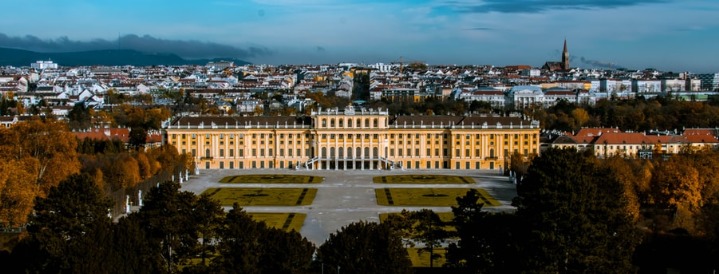Few of the world’s cities mix the past and present as effortlessly and beautifully as Vienna. The historical facade of the city is characterized by magnificent squares, grand imperial palaces and incredible baroque interiors, but at its heart, the city is one of the continent’s most dynamic urban spaces. Vienna buzzes day and night with vibrant energy, and most visitors quickly fall in love with the Austrian capital.
So much of Vienna is just simply gorgeous to look at, and one of the most beautiful buildings in the city is the Belvedere. The ornate Baroque building is a sublime masterpiece itself, and the interior art museum is equally impressive. Constructed in the early 18th century, walking through the dramatic halls, gardens and galleries is like stepping back in time to a more elegant era.
Vienna is home to a number of other engrossing museums, many of which are found in the Museums Quartier. The district is one of the world’s ten largest cultural quarters, and the ambiance there perfectly marries the past and present. Start your exploration of the area at the Leopold Museum, dedicated to Austrian modern art, then head to the Mumok museum to indulge in even more contemporary masterpieces. The museum includes a rich collection of drawings, paintings, sculptures, graphics and more by artists like Yoko Ono, Jasper Johns, Andy Warhol, Pablo Picasso and Piet Mondrian. Still more modern art can be seen at the Kunsthalle Wien, housed in a Baroque-era winter riding hall.
One of the most fun spaces in the city is the ZOOM Children’s Museum, located in the heart of the Museums Quartier. There, children are free to play and explore to their hearts’ content, and accompanying adults will also find the interactive, multi-sensory exhibits both entertaining and educational. ZOOM includes a massive art studio, film studio, underwater exploration center and temporary exhibits that convey grand themes from architecture, art, science and culture to children.
The skyline of Vienna is dominated by the neo-Gothic towers of the Rathaus, the old city hall that houses seven lush inner courtyards and an interior marked by dazzling frescos, shining chandeliers, plush red carpets and gigantic mirrors. A guided tour is required to explore the inner rooms, but the courtyards often host free concerts.
One of the greatest symbols of Austria’s heritage and culture is the Hofburg Palace, former home of the royal Habsburg family and other rulers. The oldest section of the palace dates back to the 13th-century, but nearly every inhabitant added new wings to the building, making it a fascinating example of the history of Austrian architecture. Today, the palace is home to the Austrian president and a number of small but appealing museums.
Vienna’s other palace, the Schoenbrunn, is a UNESCO World Heritage Site and the city’s most popular tourist attraction. The grand estate includes nearly 1,500 rooms and a 435-acre garden, so plan on spending the whole day exploring the palace and grounds. Guided tours take visitors through the elegantly designed Rococo rooms, but the expansive gardens are free to wander.
Other notable places to visit in Vienna include the State Opera House, the Gothic Romanesque St. Stephen’s Cathedral, the University of Vienna’s Botanical Garden, the Church of St. Charles, the bustling Naschmarkt and the Freihaus, where Mozart’s “Magic Flute” was first performed in 1791. The capital has more ties to classical music than nearly any other in the world, and visitors can also explore sites linked to Beethoven, Brahms, Strauss, Schubert and Haydn.
Vienna Geographical Location
Vienna is located in the northeast of Austria in the Vienna Basin. It is the largest city in Austria with a population of approximately 2,419,000 in the metropolitan area.
Vienna Language
German is the official language throughout Austria but Croatian and Hungarian are official in Burgenland.
Vienna Predominant Religion
- 74% Roman Catholic
- 12% None
- 5% Protestant
- 4% Muslim
- 3% Other
- 2% Unspecified
Many of Vienna’s most significant historical buildings are Roman Catholic Churches but in recent years Austria’s Roman Catholic population has declined.
Vienna Currency
The official currency of Austria is the Euro.
Vienna Climate
Vienna experiences warm summers and cold winters typically with snowfall between December and March. Precipitation is moderate and consistent throughout the year.
Vienna Main Attractions
- Schonbrunn Palace
- Historic Center of Vienna
- Belvedere Palace
Other Attraction in Vienna
- Imperial Palace
- Kunsthistorisches Museum
- Zoo Vienna
- State Opera House
